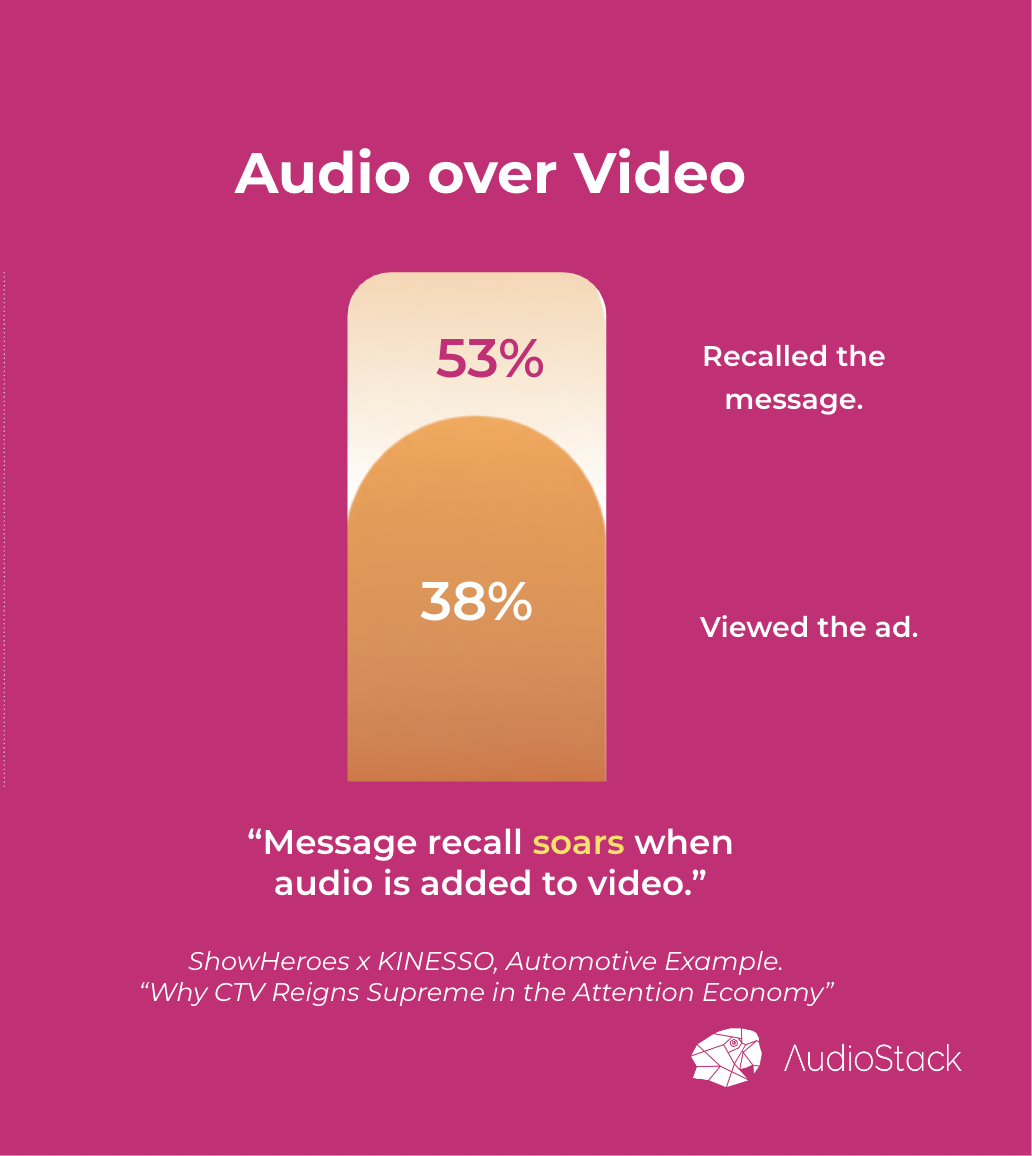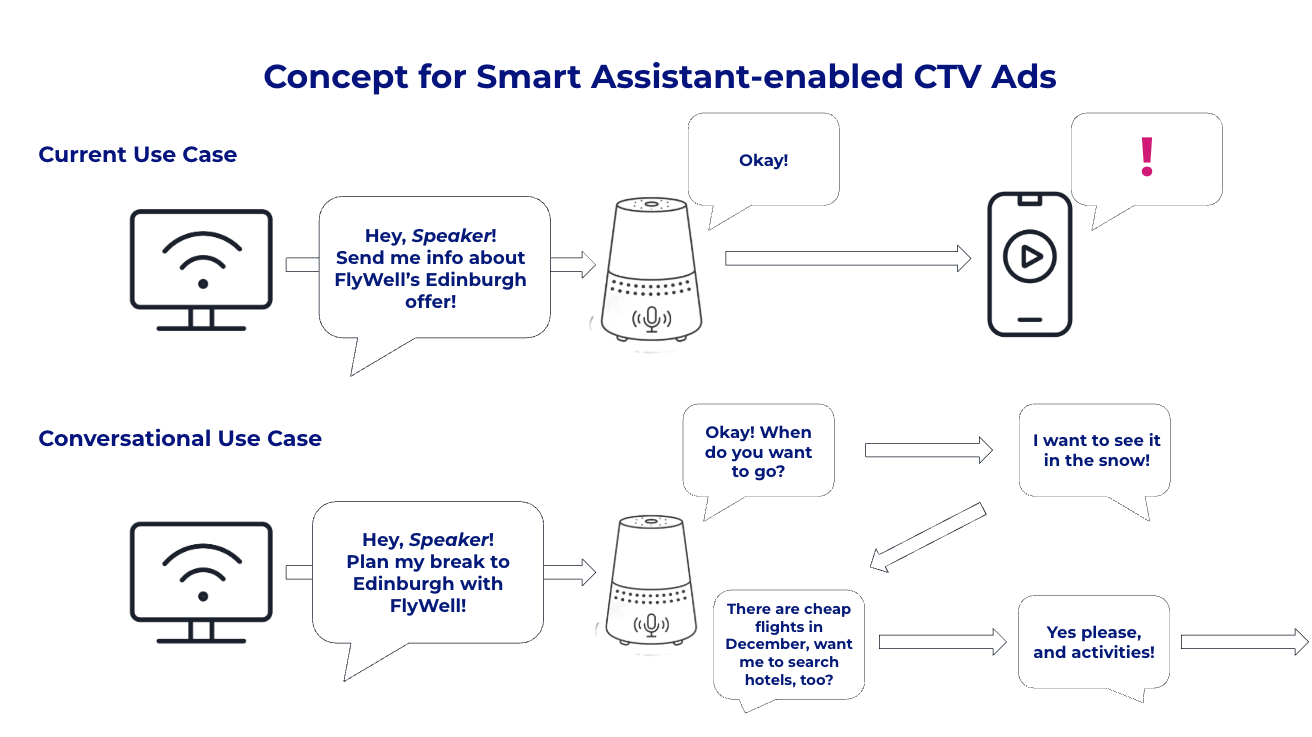TV you can talk to, SMEs with stronger audio game, and a new way of doing news – this is what we expect to transform audio, and AI is at the heart of it all. Why not take a look, and tell us what you think, asks Audiostack
Brands + Agencies
1. Brands and Agencies will need to get to grips with CTV.
In 2025, we witnessed a telling milestone in the USA. More people were streaming TV than watching broadcast TV for the first time in history (thanks, Nielsen). Not for the whole year, not every month. But a viewership that oscillates evenly between connected and cable is now official (until the NFL returns to Netflix at Xmas).
With that, brands and agencies have to keep a close eye on two screens (if they weren’t already) – and their different possibilities.
With skippable ads and more of our living-room screen time divided between the smartphone and the big screen, it’s easier to ‘ignore’ ads on CTV. Which is why, by leveraging audio over video, brands can capture attention and elevate recall (scientifically-proven)*.

Moreover, with the digital connectivity that CTV provides, targeting by data triggers such as location becomes possible – and with AI audio, it becomes very simple to do.
By overlaying AI audio callouts onto sound-off creative or, better yet, QR codes and CTAs to connect with smart assistants, brands can easily deliver higher-performing contextual advertising without breaking their backs.
We expect brands and agency ad budgets to skyrocket in this premium environment.
Extra thought: 24/7 re-runs of CSI aren’t the only thing that CTV offers.
Publishers:
2. AI news podcasts – from leading edge to editorial norm*
The use of AI to create podcasts isn’t necessarily groundbreaking at this point. But in 2026, we’ll start to see some of the more experimental applications become mainstream.
Case in point, Handelsblatt – Germany’s leading financial paper – recorded an episode of its Handelsblatt Crime Podcast on the arrest of tech entrepreneur, Daniel Starr, in France.
The podcast was recorded in German, but due to extraordinary demand from English-speaking listeners in the USA, the editorial team produced an English version. With no re-recording, and no effort, its hosts’ (Gode, Iwersen and Votsmeier) voices were translated by AI and seamlessly woven into the soundscape they had created for the German version.

The result was that they were able to capitalize on a breaking news story while it was still hot.
This is the flipside to mass production of podcasts with AI, which has been a theme that has concerned creators, as we learnt at Podcast Movement 2025. Just like we’ve seen since the release of Meta’s Vibes platform and OpenAI’s Sora 2, mass production doesn’t mean mass quality (quite the opposite).
But, what this case proves is that the technological bedrock is sound enough to help publishers automate the creation of podcasts from social and current news – and serve them to global audiences.
Learn more about how AI audio infrastructure is powering Germany’s largest financial newspaper.
Extra thought: quality-in, quality-out has never been more important.
Brands + Agencies
3. The AI-enabled smart speaker will be the next breakthrough touchpoint for B2C marketing.
When Amazon announced back in February 2025 that Alexa+ – an enhanced version of its Alexa smart assistants – was in the works, it caused a stir. Ambient (code for ‘always-listening’) and conversational, it’s opened up the possibility not just for how we talk to smart assistants, but how advertisers use them to collect data and talk back to us.
Using AI in ads is nothing new. But having them talk in natural language, with content generated that is reactive to our interactions, is.
Giving a new meaning to brand voice (pardon the pun).
Complex, conversational interactions can’t be generated in a studio (for obvious reasons). But they can (and will be) generated by AI in real-time. And not just branded voices, but immersive soundscapes – complete audio – that give brands a chance to amplify their valuable sonic identity.
Dedicated brand ‘experiences’ within smart assistants will form part of frictionless, omnichannel buyer journeys, and being prompted to strike up a conversation with your smart speaker will be a natural CTA after viewing a CTV ad.

Extra thought: Don’t read this out loud, she might hear you.
AdTech:
4. Self-serve ad creation will be key to growing publishing accounts.
Publishers as diverse as Spotify to SiriusXM have embraced self-serve media buying as a means to empower small-to-medium advertisers to advertise with audio.
However, as that market continues to expand in every field from radio to podcasting, the main constraint for publishers is shifting from inventory to production.
Without the automation that AI provides, creating an audio ad is still a manual and resource-intensive process, which limits how many advertisers publishers can realistically support.
In 2026, adtech vendors that offer self-serve ad creation to publisher platforms will have the edge. Automating basic creative steps such as scriptwriting, voice generation, and mixing will allow advertisers to launch optimized campaigns more quickly and at lower cost.
Why? Because this approach reduces operational workload for both AdOps and Creative teams on the publisher side, making it more viable to chase budgets held by smaller advertisers (who in turn, can easily go from concept to air with no need to wait on professional creative production).
Platforms that simplify ad creation will help publishers scale their businesses and capture a larger share of mid-market advertising spend.
Learn more about how AdTech providers like AdPaq and DanAds are doing this already with AudioStack's API.
Extra thought: Your local ‘Mom and Pop’ store’s audio ads are about to get a lot more polished.
Publishers:
5. Audio is news’ answer to the no-click future
As AI-driven search and summarization tools reduce click-through traffic, publishers face a structural loss of audience access. In a “no-click” environment, discovery moves off-site, and the traditional web page ceases to be the main delivery point for journalism.
This isn’t new.
What is new is the approach to resolve it – with audio providing an alternative channel of distribution that preserves both reach and brand presence.
By converting written articles into audio, producing daily briefings, and integrating content into podcast and voice ecosystems – both of which play a much larger part in our daily lives for news consumption – publishers can maintain direct audience relationships without relying on web visits.
What’s more, these new audio streams become eminently monetizable, allowing for inventory in pre and mid-roll ads, as well as paywalled content incentivising users to subscribe for ad-free experiences and exclusive journalism.
Even if audiences are fragmenting, publishers that invest in scalable audio workflows — alongside clear disclosure and authenticity frameworks such as C2PA — will be best positioned to adapt to the AI-led media landscape in 2026.
Extra thought: if ads become less intrusive than they currently are on news sites, all the better…
That’s a wrap on our predictions for 2026. There’s much more we can talk about (and already have) – but if the questions above turn on a lightbulb in your head, get in touch, and we can talk more about how we can help you make audio your advantage in 2026.
Posted on: Tuesday 25 November 2025